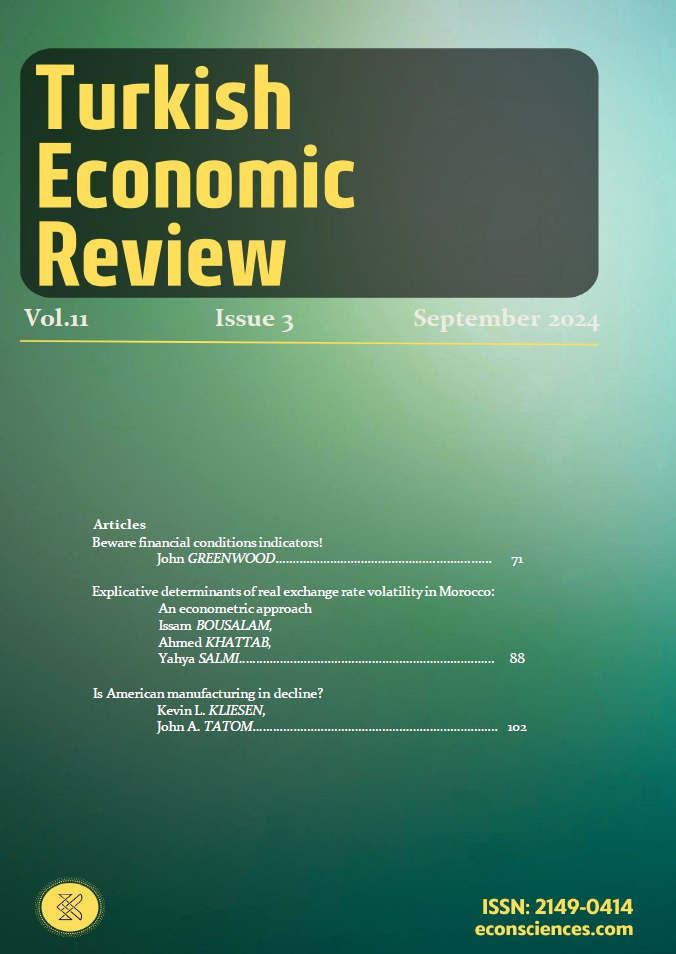Abstract
This paper aims to present a theoretical framework regarding the determinants of Moroccan Real Effective Exchange Rate (REER) volatility and to define the influential factors affecting it for the Moroccan economy between 1980 and 2020. This objective is primarily motivated by the recent changes adopted by Moroccan authorities towards a flexible exchange rate regime, which includes a progressive widening of the fluctuation range of the exchange rate. In this study, we used a GARCH(1,1) model and applied an Error Correction Model (ECM) with an estimation of the Autoregressive Distributed Lag (ARDL) approach. We found strong evidence that, in the long run, foreign direct investments, commercial openness, and terms of trade have a statistically significant negative impact on the volatility of the Moroccan REER, while the latter has a positive influence. Additionally, external debt, public expenditure, and the applied exchange rate regime positively affect REER volatility; in other words, they contribute to increased volatility in the foreign exchange market and the Moroccan economy. Conversely, the money supply has a negative impact, and the inflation rate has a positive effect on the studied volatility; however, these last results are not statistically significant.
Keywords. Real Effective Exchange Rate; Exchange Rate Volatility; GARCH Model; Error Correction Model; ARDL; Monetary Policy.
JEL. F31, F41, C22, C53, E52, C32.
References
Adusei, M., & Gyapong, E.Y. (2018). The impact of macroeconomic variables on exchange rate volatility in Ghana: The Partial Least Squares Structural Equation Modelling Approach. Research in International Business and Finance, 42(C), 1428-1444. https://doi.org/10.1016/j.ribaf.2017.07.081
Ajao, M.G. (2015). The determinants of real exchange rate volatility in Nigeria. Ethiopian Journal of Economics, 24(2), 43-62.
Ajao, M.G., & Igbokoyi, O.E. (2013). The determinants of real exchange rate volatility in Nigeria. Journal of International Studies, 2(1), 459-471.
Alagidede, P., & Ibrahim, M. (2017). On the causes and effects of exchange rate volatility on economic growth: Evidence from Ghana. Journal of African Business, 18(2), 169-193. https://doi.org/10.1080/15228916.2017.1247330
Asiama, J.P., & Kumah, F.Y. (2010). Determinants of real exchange rate movements: Evidence from a panel of African countries. West African Finance and Economic Review, 2(2), 48-88.
Bakkou, O. (2016). Politique du taux de change et les défis de la mondialisation (Doctoral dissertation). Université Mohamed V Rabat, Rabat-Agdal.
Bakkou, O. (2015). Flexibility of the exchange rate regime and exchange regulation in Morocco. Journal of Applied Finance and Banking, 5(4), 163-174.
Balassa, B. (1994). The purchasing power parity doctrine: A reappraisal. Journal of Political Economy, 72(6), 584-596. https://doi.org/10.1086/258965
Bénassy, Q. (1999). Optimal pegs for East Asian currencies. Journal of the Japanese and International Economies, 13(1), 44-60. https://doi.org/10.1006/jjie.1998.0410
Bénassy-Quéré, A., Fontagné, L., & Lahrèche-Révil, A. (2001). Exchange-rate strategies in the competition for attracting foreign direct investment. Journal of the Japanese and International Economies, 15(2), 178–198. https://doi.org/10.1006/jjie.2001.0472
Bollerslev, T. (1986). Generalized autoregressive conditional heteroskedasticity. Journal of Econometrics, 31(3), 307-327. https://doi.org/10.1016/0304-4076(86)90063-1
Calderon, C., & Kubota, M. (2018). Does higher openness cause more real exchange rate volatility? Journal of International Economics, 110(C), 176-204. https://doi.org/10.1016/j.jinteco.2017.08.002
Cevik, S., Harris, R., & Yilmaz, F. (2015). Soft power and exchange rate volatility. IMF Working Paper, 1-34. https://doi.org/10.1111/infi.12117
Dickey, D.A., & Fuller, W.A. (1981). Distribution of the estimators for autoregressive time series with a unit root. Econometrica, 49(4), 1057-1072. http://dx.doi.org/10.2307/1912517
Dickey, D. A., & Fuller, W. A. (1979). Distribution of the estimators for autoregressive time series with unit root. Journal of American Statistical Association, 74(336a) 427-431. https://doi.org/10.1080/01621459.1979.10482531
Engle, R. (1982). Autoregressive conditional heteroscedasticity with estimates of the variance of United Kingdom inflation. Econometrica, 50(4), 987-1007. https://doi.org/10.2307/1912773
Engel, C. (1993). Real exchange rates and relative prices: An empirical investigation. Journal of Monetary Economics, 32(1), 35-50. https://doi.org/10.1016/0304-3932(93)90034-D
Engel, R.F. (1982). Autoregressive conditional heteroscedasticity with estimates of the variance of U.K. inflation. Econometrica, 50(4), 987-1008. https://doi.org/10.2307/1912773
Hassan, A., Abubakar, M., & Dantama, Y.U. (2017). Determinants of exchange rate volatility: New estimates from Nigeria. Eastern Journal of Economics and Finance, 3(1), 1-12. https://doi.org/10.20448/809.3.1.1.12
Insah, B., & Chiaraah, A. (2015). Sources of real exchange rate volatility in the Ghanaian economy. Journal of Economics and International Finance, 5(6), 232-238. https://doi.org/10.5897/JEIF2013.0517
Johansen, S. (1988). Statistical analysis of cointegration vectors. Journal of Economic Dynamics and Control, 12(2), 231-254. https://doi.org/10.1016/0165-1889(88)90041-3
Khin, A.A., Yee, C.Y., Seng, L.S., Wan, C.M., & Xian, G.Q. (2017). Exchange rate volatility on macroeconomic determinants in Malaysia: Vector error correction method (VECM) model. Journal of Global Business and Social Entrepreneurship, 3(5), 36–45.
Mirchandani, A. (2015). Analysis of macroeconomic determinants of exchange rate volatility in India. International Journal of Economics and Financial Issues, 3(1), 172-179.
Morana, C. (2009). On the macroeconomic causes of exchange rate volatility. International Journal of Forecasting, 25(2), 328–350. https://doi.org/10.1016/j.ijforecast.2009.01.013
Mpofu, T. (2016). The determinants of exchange rate volatility in South Africa. Economic Research Southern Africa (ERSA) Working Paper, No.604.
Oaikhenan, H.E., & Aigheyisi, O.S. (2015). Factors explaining exchange rate volatility in Nigeria: Theory and empirical evidence. Economic and Financial Review, 53(2), 47-77.
Peseran, M.H., Shin, Y., & Smith, R.J. (2001). Bounds testing approaches to the analysis of level relationships. Journal of Applied Econometrics, 16(3), 289-326. https://doi.org/10.1002/jae.616
Ragbi, A. (2013). Ciblage de l’inflation et flexibilisation du régime de change au Maroc (Doctoral dissertation). Université Mohamed V Rabat – Agdal.
Samuelson, P. (1964). Theoretical notes on trade problems. Review of Economics and Statistics, 46(2), 145-154. https://doi.org/10.2307/1928178
Stancik, J. (2007). Determinants of exchange rate volatility: The case of the new EU members. Journal of Economics and Finance, 57(9-10), 414-432.
Zerrin, K. (2018). Determinants of exchange rate volatility: Empirical evidence for Turkey. Journal of Economics, Finance and Accounting, 5(2), 204-213. https://doi.org/10.17261/Pressacademia.2018.825
Williamson, J. (1994). Estimates of FEERs in estimating equilibrium exchange rate. Institute of International Economics. Washington, DC, 177-224.

This work is licensed under a Creative Commons Attribution-NonCommercial 4.0 International License.
